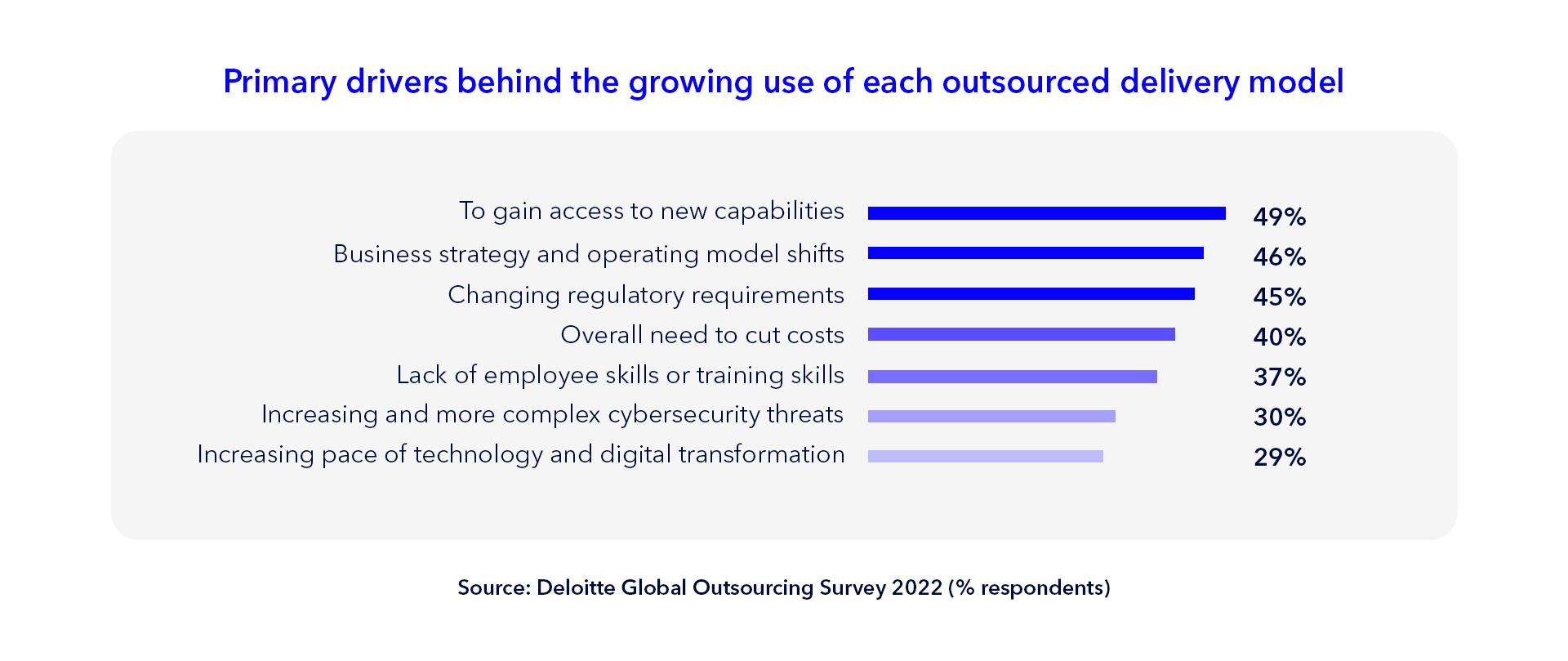In a world where every second counts in the race for innovation, is outsourcing your tech team the secret weapon companies have been searching for? Recent studies show that 60% of startups have considered outsourcing to expedite their product launches. With the global tech scene becoming increasingly interconnected, it's not just about bridging skills gaps; it's about accessing a world of expertise that no single in-house team can offer.
However, outsourcing is not without its challenges. Navigating cultural differences and ensuring seamless communication can pose significant hurdles. In today's rapidly evolving tech-driven landscape, organizations aren't just seeking to drive value or implement comprehensive solutions; they're looking to remain relevant, agile, and ahead of the curve. The rise of highly specialized developers, attractive cost-effectiveness, and enhanced flexibility further strengthen the case for outsourcing, especially during economic downturns.
A Deloitte survey on Global Outsourcing reported that 87% of IT companies were exploring nearshore outsourcing as a strategy to cut costs.
In today's competitive landscape, finding the perfect talent at the perfect price feels like hunting for a needle in a haystack. This monumental challenge has catapulted outsourcing to the forefront of organizational strategies. While the allure of cost savings, unparalleled expertise, and adaptability is undeniable, it's essential to peel back the layers and understand the true price of such a decision.
What drives companies to outsource their projects?
Venturing into the realm of tech outsourcing can feel like stepping into uncharted territory, with looming shadows of data breaches, quality mishaps, and the sheer unpredictability of it all. Yet, with meticulous strategy, open channels of communication, and a trustworthy partner by your side, these apprehensions aren't just manageable—they become stepping stones to success.
Just two years ago, 70% of executives outsourced primarily to reduce costs. Now, the narrative has changed. While cost-efficiency remains important, it's no longer the pinnacle. Today's organizations prioritize unlocking new capabilities, adapting business strategies, and keeping pace with technological and regulatory shifts.
In this changing landscape, there's a growing trend: organizations are leaning towards service providers who deliver agile, integrated solutions tailored for today's remote work environment.

In-house IT vs. Outsourced IT
The choice between in-house and outsourcing has always sparked an ongoing dialogue. There's a reluctance to step away from in-house IT support due to the concerns mentioned before.
Let's take a closer look at the often-overlooked expenses businesses face when managing an in-house IT department vs. an outsourced IT, so you have a clear picture of the real costs involved:
| In-house IT | Outsourced IT | |
|---|---|---|
| Recruitment cost | When bringing on new talent, the expenses aren't just limited to their salaries. The investment in time, money, and effort for onboarding and training can be substantial. Additionally, offering competitive benefits to retain them and funding certifications for upskilling can further strain your resources. |
By pivoting to outsourced IT, businesses can bypass these recruitment hurdles. These providers come equipped with a reservoir of skilled professionals primed to tackle varied tech obstacles. This not only saves on immediate recruitment expenses but also allows businesses to channel their resources and energy into core operations, leaving the heavy lifting of talent acquisition to the experts. |
| Turnover cost | Employee turnover can disrupt projects and workflows, leading to knowledge gaps and delays. Replacing and training new employees incurs expenses, both in terms of time and money. High turnover rates can also negatively impact team morale and productivity. |
Outsourcing mitigates the risk of turnover-related disruptions. Service providers typically have strategies in place to manage staff turnover without affecting project timelines. Your business won't bear the brunt of recruitment, training, or knowledge transfer costs when an outsourced team member is replaced. |
| Equipment and software | Providing an in-house IT team with the necessary hardware and software can stain your business's budget. Regular updates and maintenance further contribute to the costs. |
Outsourcing partners are responsible for their team’s equipment and software needs. This eliminates the need for capital investments in technology infrastructure and the ongoing financial burden of upgrades and maintenance. |
| Quality Assurance and accountability | Ensuring consistent quality and accountability requires robust management and supervision. Mistakes or lapses in the in-house team's work can have a direct impact on the organization's operations. |
Reputable outsourcing providers adhere to service level agreements (SLAs) that define performance expectations and consequences for underperformance. This contractual accountability ensures a high level of quality and minimizes the need for micromanagement. |
| Data Security and Intellectual Property | Safeguarding sensitive data and intellectual property demands significant investment in cybersecurity measures. Breaches or leaks can result in severe financial and reputational damages. |
Established outsourcing companies prioritize data security. They have experience implementing robust security protocols and can offer specialized expertise in protecting sensitive information. This level of security is often more robust than what small to medium-sized businesses can achieve on their own. |
| Scalability and Flexibility | Scaling an in-house IT team quickly in response to business needs can be challenging. Overstaffing during slow periods or understaffing during surges can lead to inefficiencies. |
Outsourcing offers unparalleled scalability and flexibility. Providers can swiftly adjust the team size to match project demands. This agility ensures optimal resource allocation, enhancing overall productivity. |
Determining the cost of outsourcing
Before diving into IT outsourcing, it's vital not just to consider its benefits but also to grasp the elements influencing its cost. This understanding will determine if such a move aligns with your business's objectives. Outsourcing costs can fluctuate significantly, depending on various pivotal factors.
By grasping these variables, businesses can craft decisions tailored to their unique requirements and financial boundaries.
Factors influencing the cost of outsourcing include:
1. Type of outsourcing
Whether it is a product or hiring staff, you should consider the following:
Product
There are many types of product projects software development outsourcing can work with, such as:
- Brand new product. When outsourcing the development of a brand-new software product, businesses are essentially starting from scratch. This type of project involves conceiving, designing, and building a completely novel solution to address a particular business need.
- Software integration. Integrating software involves bringing together different applications or systems to work seamlessly as a unified solution. This type of outsourcing is often undertaken to improve business processes, enhance data flow, or streamline operations. Whether you want to introduce a modern feature or API and incorporate a database into your product by building one yourself or with the help of third-party services.
- Product modernization. Modernizing an existing application or software is a strategic move to enhance performance, user experience, and security. Outsourcing this process can rejuvenate outdated systems without straining internal resources.
Work modality
There are two types of scenarios, team augmentation and staff augmentation. The cost of each is influenced by the specific needs and goals of the business.
- Team augmentation. Team augmentation involves bringing in an entire team of skilled professionals to work alongside the existing in-house team. This approach offers a comprehensive and collaborative solution to address specific projects or business needs.
- Staff augmentation. involves hiring individual skilled professionals to work as extensions of the in-house team. This approach is ideal when specific expertise is needed for a limited period or a recurring project.
2. The software complexity
Crafting sophisticated software solutions, be it in-house or through outsourcing, requires a significant investment. When venturing into outsourcing, the key lies in partnering with an entity adept at navigating the complexities, backed by a proficient team and cutting-edge technology.
Understand that tailor-made solutions, while intricately aligned with user objectives, call for a confluence of expertise, resource commitment, and innovation. This fusion doesn't just escalate the investment but also amplifies the transformative value the software imparts to your enterprise.
3. Size
Regardless if the software development goes under the hand of the in-house or the outsourced team, the cost options are determined by how large the project is. The scope of the project, measured in terms of the number of features, modules, and functionalities, plays a pivotal role in determining the cost.
If the project you need to develop is large, your remote product development team must be proportionally larger, which requires more resources, time, and coordination, ultimately increasing the final price.
4. Development stage
The juncture at which a company enlists an external partner also sways outsourcing expenses. Some dive in from the outset, nurturing and scaling their product with a dedicated nearshore team. Others sculpt a Minimum Viable Product (MVP) internally or with different collaborators, only pivoting to their selected external powerhouse for the finishing touches.
5. Available resources
Outsourcing costs are intricately tied to the arsenal of resources available internally. When an organization's in-house team is equipped with specific assets, be it design templates, proprietary tools, or niche expertise, it alters the dynamics of collaboration. An outsourcing provider, recognizing these contributions, might recalibrate their pricing structure. Such synergies not only lead to cost adjustments but also foster smoother transitions and more efficient collaborations, ensuring both teams leverage their strengths for optimal results.
6. Additional service and support
Post-development, the real costs often lie in the nuances of maintenance and support. Maintenance encompasses bug fixes, patches, and updates to align software with industry shifts and user demands. Support isn't just troubleshooting; it includes technical assistance and user training. As you evaluate outsourcing options, it's pivotal to account for these sustained expenses in your overarching budget.
How to choose the right outsourcing company worth your money?
1. Make sure it has a track record of experience
Choosing the right outsourcing partner is akin to savvy shopping. Before entrusting your company's invaluable data and software aspirations, you'd undoubtedly seek insight from peers and prior clients. Platforms like Clutch serve as a beacon in this journey, offering credible reviews and rankings for IT firms. Amidst the vast sea of choices, navigating through resources like Clutch's Top 1000 Global Companies becomes indispensable.
After all, there's a comfort in partnering with entities that have not only earned their stripes on such platforms but also bring a legacy of over a decade in software development, much like our own illustrious journey punctuated by myriad successful projects.

2. Culture and time zone match
Many enterprises chase savings by looking beyond their borders, but it's the often-overlooked cultural nuances that can significantly influence success. While shared cultural practices or time zones might not initially seem paramount, they lay the groundwork for an enduring, synergistic partnership. Take, for example, the bond between the United States and Latin American countries: Their aligned work ethic and overlapping time zones pave the way for streamlined communication and collaboration. It's in such details, grounded in experience and understanding, that the true essence of a seamless outsourcing relationship is found.
3. Solid online presence
In our digital-first world, our inaugural rendezvous with a brand invariably starts online. Stumbling upon a dated website or dormant social media channels can quickly trigger skepticism.
Yet, companies that not only ace their digital presentation but also attend diligently to the nuances above, radiate an aura of reliability and professionalism. These signs aren't mere digital cosmetics. They are a testament to a partner's commitment and often a direct reflection of their credibility and earnestness in the outsourcing arena. In essence, a robust online footprint is a silent, steadfast advocate of their dedication.
Ready to outsource your IT?
Navigating the intricate maze of IT outsourcing is a deliberate dance of assessing advantages, deciphering costs, and recognizing pivotal partner attributes. Armed with this knowledge, you stand poised to make a decision tailored to your organization's heartbeat.
Venturing into fresh software realms? Integrating systems? Or perhaps ushering your applications into a new era? Whatever your quest, remember: the right outsourcing partner isn't merely a ticket to savings. They're a gateway to transformation, a catalyst that merges unparalleled proficiency with the harmony your business deserves. Why settle for the ordinary when the extraordinary is within reach?


